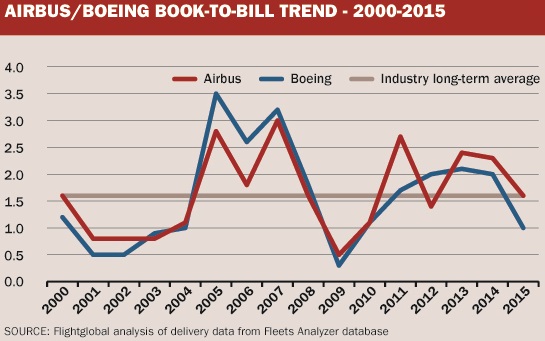Airbus and Boeing saw dramatic declines in their book-to-bill ratios last year as their combined result fell below the industry’s long-term average.
Analysts expect this trend to continue in the near term but do not see it as an indicator that demand for new aircraft is softening.
Between them, Airbus and Boeing boosted output in 2015 by 3% to almost 1,400 aircraft. But their order intake declined more than a third from the all-time commercial jet record of 2,888 net orders in 2014, to 1,804 net sales. While this is still a respectable tally, it is the first time that combined net orders has dropped below the 2,000-mark since 2010.
The result of the rising production and declining sales gave them a combined book-to-bill of 1.3, below the long-term average of 1.6.

Airbus’s higher order tally and lower production (1,036 net orders and 635 deliveries) gives it an order/delivery ratio of 1.6. Boeing’s deliveries outstripped its rival by almost 130 aircraft (762 shipments). It matched its output with new sales, securing 768 net orders in 2015. And after four consecutive years of double-digit growth, the combined jet backlog rose by just over 3% in 2015.
Rob Morris, head of consultancy at Flightglobal’s Ascend analysts, says that while book-to-bill can be a strong indicator of the demand cycle, he thinks other factors are currently at play.
“Right now, we look to be headed below the long-term book-to-bill average,” he says. “But let’s be clear, this is not a sign of weakening demand at present. The backlog can’t grow forever.
“This time around, it’s probably a manifestation of the strong backlog and the fact that manufacturers have no slots to sell for many years in the future. Therefore we expect the book-to-bill to be below the long-term average at least in 2016, and potentially for a couple more years.”
Source: Cirium Dashboard


























